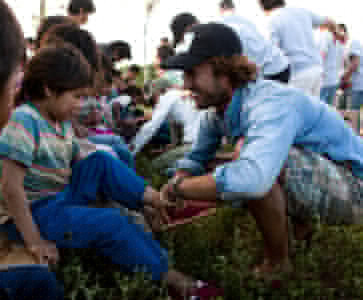 Social entrepreneur Blake Mykoskie provides shoes to children in Argentina (here) and elsewhere. (Photo courtesy of TOMS)
Social entrepreneur Blake Mykoskie provides shoes to children in Argentina (here) and elsewhere. (Photo courtesy of TOMS)
This post is part of a special report on social innovation from What Matters, McKinsey & Company’s journal of ideas, in which innovators from around the world share their strategies.
I never meant to get into the shoe business and would have said you were crazy if you told me five years ago that’s what I’d be doing today. The idea to start TOMS came during a trip to Argentina back in 2006. I met some volunteers who were holding a shoe drive to collect used or slightly worn shoes for children in the community. One of the volunteers explained that many kids lacked shoes, an absence that not only complicated every aspect of their lives but also exposed them to a wide range of diseases. I spent a few days traveling from village to village, witnessing the real effects of being shoeless: the blisters, the sores, the infections—all the result of the children not being able to protect their feet from the ground. I wanted to do something about it. But what?
Like many would-be philanthropists, my first thought was to tackle the problem head on: I could start my own shoe-based charity, but instead of soliciting shoe donations, I would ask friends and family to donate money to buy the right type of shoes for these children on a regular basis. But, of course, this arrangement would last only as long as I could find donors. That was the traditional model of philanthropy: identify a cause and initiate a never-ending hunt for donors. I wanted something more sustainable. These kids needed more than occasional shoe donations from strangers—they needed a constant, reliable flow.
Then I began to look for solutions in the world I already knew— business and entrepreneurship. An idea hit me: Why not create a for-profit business to help provide shoes for these children? It was a simple concept that I call One for One: Sell a pair of shoes today; give a pair of shoes tomorrow. And that’s when TOMS was born.
Are you enjoying this article? Read more like this, plus SSIR's full archive of content, when you subscribe.
So far, Toms has given more than two million pairs of new shoes to children in need and recently launched its second One for One product, TOMS Eyewear. TOMS is only one example of a new breed of company that is succeeding at this volatile moment in capitalism. In this fast-paced and constantly mutating world, it is easier than ever to seize the day; but in order to do so, you must play by a new set of rules—because increasingly, the tried-and-true tenets of success are just tried, and not true.
What we’ve found is that TOMS succeeded precisely because we have created a new model. Business and philanthropy are no longer mutually exclusive. We’ve been able to find a sustainable way to give in the areas we serve. Through a simple purchase, a consumer is making a direct impact on someone’s life around the globe. There are no formulas or percentages. It’s simple. You buy something today and help someone tomorrow. One for One.
The giving component of TOMS makes our shoes and eyewear more than a product. They’re a part of a story, a mission, and a movement anyone can join. That, it turns out, is a compelling proposition.
Support SSIR’s coverage of cross-sector solutions to global challenges.
Help us further the reach of innovative ideas. Donate today.
Read more stories by Blake Mycoskie.

